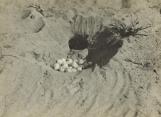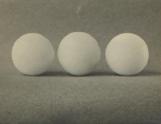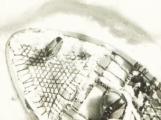14
Charles Macnamara became an expert on the Canadian Ruffed Grouse. He wrote about the increase in population from 5 to 28 birds after one year of establishing the Nopiming Game Preserve. He started studying the Ruffed Grouse in 1912 and submitted an article to The Canadian Naturalist magazine that year. In the1940's he photographed the scales that the Ruffed Grouse grows in the fall, shown here. He also photographed the imprint of the grouse's wings on the snow when it bursts out of its burrow and often recorded sightings in his notebooks.16
In 1914, Macnamara recorded the movements of a snapping turtle he found around Goodwin's Bay. There were three nests of 31, 45 and 49 eggs laid on the sandy beach between June 13th and June 16th. Later, Macnamara opened up a nest to study the eggs which he discovered were perfectly round.18
Charles Macnamara brought these snapping turtle eggs home from Goodwin's Bay. He observed that they were perfectly round while the painted turtle's eggs were smaller and oval.20
In 1918, Charles Macnamara published an article in The Ottawa Naturalist about a family of Chimney Swifts that had nested in the fire guard in the hearth of an unused cottage at Marshall's Bay.22
Winter Walk24 February 1924
by Charles Macnamara
Three days ago there was a splendid snow storm. True it delayed all the trains and blocked the roads and everybody in town had to cut deep pathways through their backyards. It interfered with the little ways of mankind and they grumbled about it. But in the woods and fields it has effaced all old tracks and has spread a new clean sheet for wild creatures to write their doings on. And so it pleases me.
It was 18 degrees below zero in the night and when I start out from the house at 10 o'clock it is still 3 degrees below. There can be no finer weather in the world than this. A calm day with a brilliant sun in the bluest of cloudless blue skies, sharp clear horizons, the distant snow covered hills, the old Laurentians ground down into low curves by the slow weathering of inconceivable eons of time; are seamed with deep blue shadows and are so unnaturally close that stunted trees can be seen fringing their skyline. The snow in the fields and clearances has been ribbed and carved by the wind and beaten so hard that the snowshoe scarcely makes a mark on its surface. In the woods it is softer and some places the walking is heavy. One sinks four or five inches at every step. Everywhere the surface is glistening with cold sparks where minute snow crystals catch the sun. Sinbad's valley of diamonds must have been a dull place compared to this. This is a whole vast country thickly sown with diamonds.
I walk out the road half a mile before I turn off into the fields, slightly scandalizing the people driving into church. Most of them know me however and have become used to my heathenish ways. The field gate is wide open and it could not be closed without digging it out of the drift that half buries it. But it does not matter. There are no horses to be kept in now. The first wood I came to is known as Mackies Bush from a farmer long dead owner. It is all hardwoods mostly maple, with some hard grown little ironwoods mixed in among them, and one uncommon tree, a large black cherry, the only one of its kind I know of for miles around. White foot mice were out last night running neat little trails over the snow, and risking their lives in the open. No owl caught them this time, but here close to a maple trunk is evidence of a tragedy.
In a small expression in the snow are the mangled remains of a flying squirrel, easily identified by the soft wide tail. The little animal was evidently struck from a branch high overhead, and borne to the ground by some bird of prey. The wing marks on the snow show a comparatively small spread. The flying squirrel comes out at night, so it was probably an owl that caught it, and from the small size of bird, it is safe to say a screech owl. I am sorry for the beautiful soft little grey creature with its large black eyes reduced to this bloody shapeless mass but who am I to condemn the owl. Had I not lamb for dinner yesterday?
The ruffed grouse is so universally known as the partridge that while it is not really a partridge at all, it seems pedantic to call it anything else in the country. This is great weather for them. The nights are very cold, but the snow is deep and soft, and they are able to burrow into it easily to sleep warm and protected. I see several deserted burrows, and presently a partridge bursts out at my feet.
I now come out of this wood and set my course across the fields of the Brown Farm. Homely unpicturesque names these, but there is something downright and genuine about them, like home-spun cloth. They are full of the artificiality of Idlewild or Bellevue or some other finikin name of the sort.
Every week I snowshoe over this route, but the late storm has almost obliterated my old track. Breaking a new road through the soft snow is heavy warm work. If I can follow my former path the walking will be comparatively easy. The old track is visible to the experienced eye as a faint hollow more easily seen at a distance then close in front. You soon know when you step off of it. It is heavy enough going on, but it is a great deal heavier off it. Thus sometimes when a track is drifted over and no trace of it can be seen it is still possible to walk on it by a kind of faith if not by sight for the slightest deviation from it is known instantly by the softness of the footing. The great thing in snowshoeing is not to go too fast. If you do, you tire yourself out, and even worse you get too warm. I remember seeing an Indian on the Kippewa as I was driving one very cold winter morning. There was his rude little cabin on an island with a wisp of smoke rising straight up into the [clean] air and he was starting out across the wide lake to go somewhere on snowshoes. It was a long way to anyplace, but the snow was heavy and he was sauntering along like a loiterer on a promenade. Time means little to an Indian, but he knew he would reach his destination sooner by taking it easy, than by hurrying up and exhausting himself.
While still out in the middle of the field I hear from the wood in front the light tapping of a woodpecker. Probably a "hairy", a common winter bird in these parts. It certainly is not a "pileated" with his hatchet blows, which have actually deceived me once or twice into thinking there was a man chopping wood nearby. Perhaps it is only a "hairy" but bird life is very scarce this winter, and on principal I investigate every bird I hear or see. I am glad I did this time, for there on a dead spruce at the edge of the wood was a fine male American three toed woodpecker with his yellow crest and "ladder back", the first I had ever seen in life! I was delighted to see this rare bird.
Passing through a strip of trees another partridge burst from the snow at my feet. The partridge has explosive habits. Its startling suddeness doubtless often saves it life. A little farther on where the first spring flowers come out (all buried deep in the snow now) I traced another tapping to a slender white birch, again expecting a "hairy"; and this time it was an Arctic three-toed, not so rare as the American three-toed, but still an uncommon bird. It was a female and its blue-black back shone in the sun like the plumage of a purple martin. These two good records put me in quite a good humour.
I went wandering through the woods looking for grouse in their burrows and found none. The tramping was very heavy in among the trees, but fair and soft goes safely, and safely goes far. Next I remembered that I had to call on a fox family that lived on the side of a deep little ravine. They are not hospitable people, and neither invite me in nor come out themselves while I am around. And this attitude is justified. Man the destroyer is worthy of no confidence. It is only shy suspicious wild animals that exist near mankind in this wicked world. Tracks radiate in all directions from the burrow and there are half a dozen smooth depressions around where members of the family have sat in the snow to enjoy the sunlight.
"The traitor snow betrays the timid hare, and all the stealthy wanderings of the fox". On across the dazzling fields, skirting the edge of the wood where the sumachs grow. Squirrels have been breaking of the crimson plush seed masses and eating the sour seeds. Then out of the brilliant light into the dark balsam wood. I like this place. Coming from the sunlight outside it seems quite dark. The trees are close & the branches are low and the sky is not to be seen. The balsam or more accurately the balsam fir, is not much esteemed by lumbermen, though pulp & paper makers use large quantities of it. Nevertheless it produces one of the most important substances in the world, that is Canada balsam, universally used as a cement for lenses of all kinds. Photography, microscopy, astronomy, and eye sight itself are all greatly indebted to this humble tree. The "balsam" is in the little blisters that speckle the smooth bark of the trunk.
Last Sunday when passing through this wood, I caught signs of a blister of pine tassels and twigs under white pine on a rocky hillside. The snow surface is in general as clean that any such untidiness is very conspicuous. This is the mark of porcupine feeding in the tree, and table manners being very unrefined, he lets many pieces drop to the ground which attracts a concourse of hares who are very fond of these tender pieces. I was over to investigate and saw the porcupine on a branch, motionless blinking in the sun. I wanted to find out where he came from, and searched around the tree for his track but could only find a short path to a small hemlock nearby which he had gone to for a slight variation of diet and returned to his white pine. (A porcupine track is easily identified. In this deep snow it is a trench. The short legged thickset little animal has to fairly plough his way through. Hare often follow regular courses which become well marked paths, but owing to the leaping gait of the hare, the track is not a continuous groove like that of the porcupine, and always has unbroken gaps in it.) The porcupine had evidently been living in the pine tree for an indefinite time.
This Sunday I visit the tree again. The heavy snow fall since last Sunday has effaced all old tracks, and if the porc had been down since he could not fail to leave his mark. There was none. He had continued to live up in the tree, and was again sitting on a branch stretching out towards the south.
Out of the thick wood onto the beaver meadow. Another partridge burst out at my feet, a late riser, this one. It is now noon, and the temperature has warmed considerably. The beaver works are buried deep in the snow. Many people would pass this way without seeing the dams and houses. Little Brother Muskrat's house is only a low [pile] of snow, but to Brer Fox it has an appetizing smell and he cannot go by with [out] stopping to smell at it and scratch a little mud out of the side. But it is frozen too hard for him, and he trots on, and climbs up the beaver house and sniffs at the air holes. Probably smells to him like beefsteak and onions to a hungry man.
A long narrow stripe of crisp cirrus cloud drifts broadside overhead. The wind must be rather strong five or ten miles up there. Down here in the forest the air is still, but in the tops of the pines there is a sound like waves on a far off shore. Except for this from time to time, the silence is perfect. I stop and listen and the silence aches. And at last I imagine I hear distant sleigh bells but it is an illusion. Even when walking there is only faint creaking of snowshoes and rubbing of canvas coat, snow pads footsteps. Sometimes loud crack of frozen branch. Few birds today.
I reached log cabin and by 1:20 had it nice and warm. Lunch a little frozen, but tea in thermos bottle steaming hot, too hot to drink until it has stood a while. Chop wood for next visit, read a while, and close up camp, putting snow on fire on hearth as usual. Easy to follow track home. It is the snowshoe pioneer who has the work. Following is easy.
Where I cross a fence, I noticed last week the look out hole of a vole (observation post). A foot of snow has fallen since, but hole has been kept open to surface. No foot marks. Does not venture a toe outside. Only looks around. Probably a house underneath and many runways. Foxes dig for them sometimes.
At 5 pm American three-toed woodpecker still working away on the dead spruce. Buffon on sad laborious life of woodpecker is wrong. Nevertheless they have to work hard for a living. The lilies toil not, but our winter birds certainly do. More tapping nearby. This time a hairy. Across the field in Mackies Bush a loud signal rapping. Large pileated on dead top of maple, broadcasting a message to mate. No answer while I was there.
Home along deep-snowed road. Swarms with motor cars in summer (what road in America doesn't?). None today. A boy in a cutter driving an old white horse is all the traffic. Kindly picks me up and lets me off at end of bridge.
24
As a photographer and naturalist, Macnamara was able to appreciate and capture the beautiful and functional form of the common milkweed. Macnamara documented the colour, size and texture of various milkweed pods in one of his notebooks.26
Macnamara discovered a colony of walking fern (Camptosorus rhizophyllus) growing on a sloping limestone rock on the northerly edge of the Brown farm."Since about 1938 the ferns here have not been 'walking'. In former years ten or fifteen fronds could always be found rooted at the tips. Now there is not one, though otherwise the fronds look healthy and vigorous. The rock is not quite so well shaded as it used to be, owing to some of the nearby trees having been cut down. The difference in exposure is not much, but perhaps it has been enough to stop vegetative reproduction".






